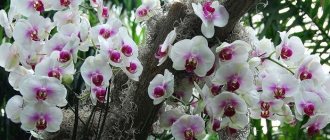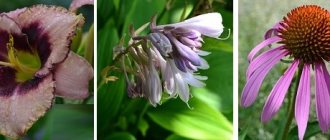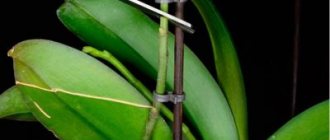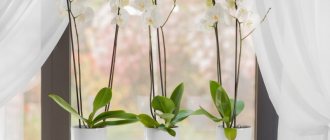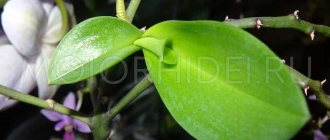The choice of container for growing orchids is of great importance for the root system of the plant. Since this is an epiphytic plant growing on trees, its roots are most often located on the surface of the tree and participate in photosynthesis.
Therefore, when choosing a flowerpot, you should give preference to a transparent plastic or glass pot.
Is it possible to plant a plant in a translucent container, is it necessary?
Orchid is a type of epiphyte. Epiphytes under natural conditions do not live in the ground, but cling to some plant and send their roots into its bark.
Almost the entire root system of epiphytes is located in open space. Such conditions cannot be provided to plants in apartments with central heating, a lot of equipment and household appliances. The roots dry out and die. The only way out is to place the plant in a pot that will provide an isolated space for the root system.
Many sources claim that the best option when choosing a pot for replanting is a transparent container . But is it necessary to plant an orchid in a transparent pot or not? Experienced flower growers claim that the owner of the orchid needs it more than the orchid itself, and that it is not at all necessary to purchase transparent containers for the capricious beauty.
Orchid pot size value
The size of the orchid pot is also important. There is no need to buy a pot that is too large for your orchid.
It is desirable that their diameter is equal to their height. Large pots for orchids mean that the soil in them will dry out unevenly, which can cause rotting of the roots.
In turn, very small pots without proper support often turn over, which leads to injury to the plant. How to choose the right size pot for an orchid? So that the root system is a little cramped.
Advantages and disadvantages
A container made of transparent material has a number of advantages:
What the transparent walls of the pot are really useful for is to monitor the condition of the orchid's roots and substrate. This allows you to regulate plant watering, timely detect diseases of the root system or identify pests.- Plastic is a substance that has no pores, so the roots of the orchid will not be able to “grow” to the walls.
- The plastic maintains the optimal temperature necessary for the root system of the flower, that is, it prevents overheating and hypothermia.
- Such pots are better than others at maintaining the required level of humidity.
- If you have difficulty separating the soil from the roots when replanting, you can cut such a pot with ordinary office scissors.
- Doesn't break when dropped.
- This type of container is a budget option.
There are also certain disadvantages:
- Lovers of everything environmentally friendly will actively oppose the use of plastic - a synthetic substance that has a negative effect on the human body and the state of the environment.
- The material from which transparent containers are made is quite light: there will always be a risk that the plants planted in them will turn over.
- In such a situation, the lack of hygroscopicity in the substance can play a bad joke: the orchid will easily fall out along with the substrate.
- Plastic pots are airtight.
- Plastic may react unpredictably to any fertilizers added to the substrate;
- The design is not aesthetically attractive enough.
The first three disadvantages are easy to eliminate: it is enough to “weight” the pot with a layer of drainage (expanded clay, pumice can be used), and to ensure access of air flow to the roots and outflow of water from the substrate, you need to make holes in the bottom and walls of the vessel (a hot nail or spoke).
Consequences of landing
When choosing a new container for your pet, you should understand the consequences of the decision.
Transparent
It is important to choose the right size so that the transparent walls do not cause the substrate to quickly dry out in small containers. It is important to mark the orchid so that it is not in constant danger of falling due to the instability of the pot.
Opaque
After watering, you must wait until the liquid is completely drained from the substrate. It is important to constantly monitor the dryness of the bark so as not to water too often and spoil the plant.
Effect on various plant species
Before planting a flower in a transparent pot, you need to take into account the specific requirements for the growing conditions of various types of this plant. The root system of Phalaenopsis and Oncidium is involved in the process of photosynthesis, for which light is simply necessary. It is advisable to grow these types of orchids in containers that transmit light.
For the Vanda orchid with its growing characteristics, a glass container is suitable , which will provide light transmission and will be convenient for constantly moving this flower for the purpose of watering and drying the roots. But for the capricious Cattleya and other hybrid orchids with pseudobulbs, glazed ceramics are recommended, as are all terrestrial species (Venus’s slipper).
What varieties is it suitable for?
Today, there is a huge number of different hybrids bred by breeders using the method of interspecific and intergeneric crossings. Among the epiphytic orchids that will require a transparent pot are the following :
- Phalaenopsis pleasant, Phalaenopsis Stewart;
- Dendrobium;
- Wanda;
- Cattleya;
- Calypso, etc.
Is the opaque option acceptable or not?
If we talk about environmental friendliness, then pots made from natural materials (clay, ceramics) are preferable. But the best option for novice florists is a plastic transparent container , since light transmission allows you to visually observe the condition of the roots and substrate.
An experienced florist, who has studied all the features of each variety of orchids and knows all their “habits,” does not need visualization. He can pay attention to ceramic and clay opaque vessels.
Flower restoration
When a flower has withered and looks lifeless, it is still quite possible to save it. To do this, you need to use a secret, which at first glance seems quite strange. You need to roll up the fallen hair remaining on the comb into a ball and bury it in the ground of a flower pot. No, this is not mysticism, this is ordinary chemistry. Hair contains nitrogen, which helps indoor plants recover quickly.
What will unstained containers help you find out?
The transparent material from which the container is made allows you to monitor the development of the root system, the condition of the substrate, and the outflow of moisture. So the color of an orchid’s roots is one of the main indicators of its condition and health . The plant does not need watering when its roots are deep green. If they gradually become silvery-greenish, then the flower is “thirsty.”
If the roots acquire a yellow, brown, or black color, it is time to sound the alarm; this is a clear signal of rotting of the root system or its fragments. In addition, transparency allows you to see how saturated the substrate is with water and when to water the plants next time.
If you really like a glass vessel in a store, then it can be used as a decorative flowerpot, but you need to remember: the distance between the walls of the pot and the flowerpot should be at least 1 - 2 cm .
Pots made from plastic bottles
In debates about which pots are best for orchids, they often use the possibility of installing automatic watering, remembering that an orchid flower in a pot requires a certain soil and air humidity.
To make your own pot with automatic watering, you can use two plastic bottles with a volume of two and one liter. The pot itself and the automatic watering system will be made from them. This is done as follows:
- To make a container for watering, a two-liter bottle is cut to a height of twenty centimeters from the bottom and its lower part is used;
- Eight cuts are made at the top, four centimeters deep, to form stands for the pot;
- The resulting segments are bent inward after one;
- To fill the container with water, the neck is cut off from the remaining upper part of the bottle;
- A hole is marked in the lower part of the manufactured drinker so that a spout can be attached;
- The neck is attached to the cut hole using thermal glue;
Read also: How to properly grow stevia at home
As you can see, pots for orchids at home can be very different, both in material, size and shape, and even in function.
Although an orchid in a pot is considered a rather capricious plant when grown indoors, the correct choice of pot for planting and proper care of the orchid in a pot at home will avoid many problems in its further maintenance. Therefore, you should decide in which pots to grow orchids in advance, before you purchase the plant.
Effect on the flower
Most experts believe that the material from which the container is made has absolutely no effect on the condition of the plant. Neither plastic nor glass can harm your favorite flower; only improper care can cause harm.
Translucent glassware
As mentioned above, a transparent pot is very beneficial for beginner gardeners . They, seeing the condition of the orchid roots, can have an adequate effect on the plant, which, of course, has a positive effect on the flower.
What are the dangers of using a regular flower container?
Despite many positive indicators, an opaque pot does not make it possible to notice problems with the roots if they arise, determine whether watering is needed, or identify the presence of pests. Such a grower must have well-developed intuition and rich experience in order to determine possible deviations in its development by the appearance of the orchid. Otherwise, the condition of the plant may deteriorate, even to the point of its death.
Lighting for good flowering
Remember: if there is not enough light, the orchid will not bloom. How to determine whether there is enough sun and whether a swollen bud will bloom? This can be seen by the color of the leaves, which usually turn dark green.
If the orchid leaves turn yellow and become covered with dry, dark red spots, it means there is too much sun. A window sill on the south side is not the best place for it. It is better to keep the plant on a cabinet or on the floor, where direct rays of the sun do not reach.
Step-by-step instructions on how to plant in different containers
From glass
Attention! The best time to replant an orchid is after it blooms. The pot should not be too large or too small; it will be enough if it exceeds the old one in diameter by 1 - 2 cm.
- Prepare the substrate, pot, expanded clay, scissors.
The plant itself should be prepared: remove it from the old pot, place it together with the substrate (if it is stuck to the roots) in warm water. After some time, remove, wash off the remaining soil from the roots and leave to dry.- When the roots of the plant are completely dried and visible, it is necessary, after carefully examining them, to remove all rotten areas with scissors.
- The bottom of the pot should be covered with expanded clay approximately 5 cm so that water can drain, and with a small layer of substrate. Place the plant on the resulting “cushion”, straighten the root system, place too long aerial roots in a pot, and fill all free spaces with substrate. It should be evenly distributed between the roots, periodically lightly squashing it; the growing point of the orchid should not be covered with bark.
- You need to make sure that the plant does not dangle in the new container.
There are certain difficulties when watering orchids planted in a glass pot without drainage holes. The flower should be watered superficially using a watering can or shower. In order to drain excess water, the container is turned over while holding the flower . For this purpose, some gardeners place moss on top of the substrate to avoid losing pieces of bark. In this way, watering is done 2 times less often than usual.
We offer you to watch a visual video of planting an orchid in a glass container:
Plastic
- Prepare everything you need for planting: pot, scissors, drainage, substrate, activated carbon, maybe cinnamon.
- Water the flower in an old pot first.
- Remove the plant from the container. To avoid injury to the roots, the old container can be cut.
- Carefully examine the roots and cut off rotten areas with scissors.
- It is necessary to remove all dry parts from the root collar of the orchid, where the plant comes into contact with the ground.
- Treat cut areas with crushed activated carbon or cinnamon.
- At the bottom of the pot we place drainage, a little bark, and a plant. The root collar should be in the center of the pot, and the roots should be around the walls of the container. When filling the pot with soil, you need to ensure that the pieces of bark evenly fill all the free space between the roots.
Important! The first watering of the orchid after transplantation should be done with boiled water on the fifth day, the second watering should be done after another 2 weeks, and feeding should begin only after a month.
Opaque
Prepare everything necessary for planting, including the plant itself.- Carefully examine the roots of the orchid, trim off any rotten or dried areas with scissors.
- According to experts, pruning areas should be treated with activated carbon or cinnamon.
- Fill the pot with drainage and some substrate, place the plant itself so that its roots are freely located around the walls of the pot. Fill the resulting voids with soil
- Tap the sides of the pot to allow the soil to settle.
Below is a visual video about planting an orchid in an opaque pot:
You can bring the conditions for growing orchids closer to natural ones by planting the plant on a block or using a special breathable container called Corona. And as a substrate, an excellent soil made in Germany, Seramis, is suitable.
Chlorophytum
Who came up with the idea that it went out of fashion?
Handsome, flexible and elegant, he brings great benefit to the home. It cleans the air, grows quickly - this is the best plant for the home.
Chlorophytums with their long leaves and babies hanging on the stems are a real decoration. Color variations range from green to white with green edges.
Chlorophytums need good watering; during long droughts, they indicate thirst with brown tips of the leaves. They will benefit from spraying in dry air.
Chlorophytums produce a lot of oxygen, absorb carbon dioxide and many harmful compounds directly from the air. And most importantly, they are not poisonous; a curious child or cat will not get hurt if they try it on their teeth.
Centenaries are a great choice. They are unpretentious and do not require much trouble. They tolerate everything: from drafts and cold to drought and hot days. They experience their hosts' vacation without noticing any inconvenience. The main thing is good drainage so that the roots do not stagnate in water.
And most importantly, aloe leaves are a ready-made first aid kit at hand. They cope with inflammation, treat pimples and wounds, and are even used to prepare products that stimulate the immune system. Aloe pulp and juice - there are plenty of ways. So an old specimen of aloe is a real family treasure; in young plants the healing effect is almost not expressed.
Aloe comes in different types. Elongated and squat, with large and small leaves, even variegated ones. The main thing is to let there be at least some.
Rescue of rotting roots
If it becomes noticeable that a houseplant is not feeling well, the leaves have wilted, and signs of rot are visible on the roots and top layer of soil, it’s time to use a simple but effective means of rehabilitation. To do this, you need to mix hydrogen peroxide and water in equal proportions, and then water the flower without flooding it too much. After a while, positive dynamics will be noticeable; if necessary, you can repeat the treatment procedure after 5 days. The most obvious sign that there is too much humidity in the pot and the roots may rot: the soil on top is covered with a white coating and mold.
Flowers for a bathroom without a window
If your bathroom does not have a window and you want to decorate it with live plants, you must create appropriate living conditions for them. Since there is no natural light, it is important to choose shade-loving species (see paragraph above), providing them with an appropriate amount of artificial light.
It is enough for an energy-saving light bulb or a regular fluorescent lamp to burn in the bathroom for about 10 hours a day. You can buy such lighting at a garden store.
Changing the lighting conditions weekly is also a good idea - you can buy two identical plants and grow them at the same time in different lighting conditions - one of them placed in the bathroom for a week, the other in a room with natural light, but not in direct sunlight.
After a week, swap the plants. This ensures that each of them receives enough light to develop, and that in the bathroom the eyes will always be pleased with a living, beautifully flowering plant.
Even one correctly selected plant can decorate the entire bathroom. For example, a single pot with a tall, lush flower will effectively decorate the space , adding shine to all neighboring elements. It will highlight the beauty of structural tiles that look like wood planks (as well as other tiles).
Healthier soil for indoor plants
Another great way to help your houseplants grow and bloom better is to water them with boiled egg water. First, the eggs are boiled, then removed from the pan, and the water cools. After this, you can sometimes water the flowers with it so that the calcium remaining there kills all pests and microbes. Excellent prevention.
Did you like the article? Then support us, click
:
